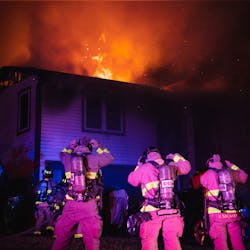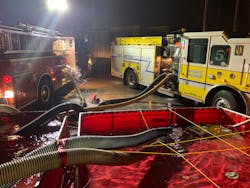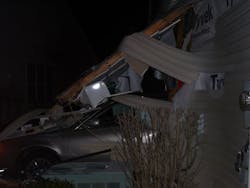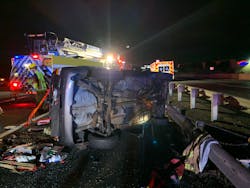When the Sun Goes Down: Nighttime Fireground Operations & Training
When the alarm is struck for a fire department response, rarely is consideration given to what time would be best to “schedule” the response. Emergencies happen when they happen, and timing is one of the factors that is out of our control. That said, preparation for such emergencies is within the department’s control, through scheduling, availability of locations, and the cooperation of neighboring resources and community support.
In reality, the training for events to which we respond mostly is done during daylight hours for a variety of reasons: Visibility is much better, locations for training have a wider availability and department members who might have responsibilities to their families at night would benefit from training during the day, even on the weekends. However, to be truly best prepared for operating in potential on-scene environments, training during evening hours should be common within the training officer’s calendar, allowing for skill development and practice during actual limited visibility.
Covering the basics
A solid focus on the basics regarding our responsibilities sets a department up for success. The foundation of skill sets is paramount. A competent and efficient firefighter not only knows how to operate all of the equipment on his/her respective apparatus but also can perform field repairs on the equipment during the emergency to keep on-scene operations running smoothly.
Many firefighters would agree that the protective equipment that’s worn during emergencies can limit performance. For example, SCBA masks limit peripheral visibility, can fog up while performing laborious tasks and can make communications difficult. Firefighting gloves make tactile tasks even more challenging. The added size of SCBA and turnout gear increases firefighter dimension, which can alter maneuverability through an area. Throw in the limited visibility and obscurity that nighttime operations can provide, and the difficulty to work in limited-sight environments can be compounded.
Training during evening hours should be performed to allow skill sets to be honed into precision steps and movements to efficiently complete tasks. Basic skills, such as tying off tools or equipment and hoisting them to upper floors, raising and setting ladders in place for ventilation, rescue and RIT, and forcing entry into doors and secured areas, should be practiced during these times to ensure competency and efficiency when the alarm comes. These skills can be practiced locally at the fire station, with limited logistical needs for quality training opportunities.Upon-arrival skills
Think about the qualification process that a probationary driver/operator goes through in your department. How many hours are performed specifically during evening hours? Many departments don’t specify driving or operating time periods during evening hours.
Consider driving through your first-due (and second-due) areas during the day, and then consider the changes that are experienced after the sun goes down. Odds are it’s a vastly different environment. From an increase in automobiles that are on the road, to pedestrians and cyclists out exercising in dark-colored attire, to even animals that might come out from wooded areas and dart across the front of the apparatus, operating apparatus at night can provide a varying set of challenges.
While rolling up, spotting a water source is critical for apparatus placement. When you add more vehicles that congest the side of the road and limit visibility, getting water to the hoselines might prove more time-consuming. Practicing placement for hydrant access during evening hours might change the intake choice on the engine, the soft suction length to the source or the positioning altogether.
Ladder placement should be considered for evening operations, too. Gaining access to tight areas becomes even tighter when the sun is down and visibility is poor. Setting up for maximum scrub for the elevated platform should be considered for congested roadways and tight maneuverability into dead-end streets and cul-de-sacs that limit turning and placement options.
Consider the task for the elevated device. Will it be to support suppression with large caliber streams, for access for horizontal/vertical ventilation or for immediate rescue for trapped occupants? Crucial time that’s spent maneuvering into position with limited lighting for visibility takes away initial time that’s needed to complete these tasks.Operational skills
Deploying resources to bring the incident to a safe and efficient closure requires a thorough size-up. Limited visibility and available lighting during evening hours can make the size-up process difficult. Tools that are available to the incident commander or the arriving officer can be utilized to gather size-up information.
Officers who are well-versed in the use and interpretation of the information that’s gained from the thermal imaging camera (TIC) can apply that information to the incident action plan. TIC data can identify potential significance of the emergency within the compartment. Interpreting the images on the TIC requires practice. Officers can perform a size-up around buildings within their first-due area, noting how normal use and occupancy can influence the palette that’s shown on the TIC. Furthermore, important clues that might be visible during the day become “invisible” under the cloak of darkness.
Scene lighting is critical for safety of all personnel during evening operations. Lighting up the scene must be done early upon arrival. In some cases, lighting might need to be set up on multiple sides of the building. Deploying power supplies and portable lighting to distant areas of the operational arena aids crews that operate in remote areas of the scene and helps to coordinate operations in all areas of resource deployment.What the dark brings
Team efficiency on the emergency scene is critical to overall success. Emergency responders must be prepared to operate at any time of day or year, in all types of weather and circumstances. Night operations increase potential injury to responders from hazards that are within the scene and from hazards that are associated with operating on roadways during evening hours. It isn’t enough to be fluent in tool/equipment use and operation. These skills must be dependable at any time that the emergency arrives, including after the sun goes down. The safety of both the responders and the people who they serve depends on it.
Incidents without Fire
Many departments provide services to their community beyond fire suppression. Medical care, hazmat mitigation and technical rescue response can add to the risk that’s associated with operating at night.
One of the more common nonfire operations is vehicle extrication. Increased risk with responder visibility, apparatus placement, patient removal and transport, and traffic control must be dealt with during the operations. Setting up extrication training can include simulated roadway responses during evening training sessions. Setting up blocking vehicles, warning devices and PPE with proper visibility markings should be utilized during the training sessions, so policies and practices are reinforced for when the time comes to use them.
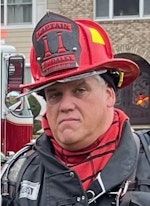
Michael Daley
MICHAEL DALEY, who is a Firehouse contributing editor, is a 37-year veteran who serves as a captain and department training officer in Monroe Township, NJ. He is a staff instructor at multiple New Jersey fire academies and is an adjunct professor in the Fire Science Program at Middlesex County College. Daley is a nationally known instructor who has presented at multiple conferences, including Firehouse Expo and Firehouse World. His education includes accreditations as a Chief Training Officer and a Fire Investigator, and he completed the Craftsman Level of education with Project Kill the Flashover. Daley is a member of the Institution of Fire Engineers and a FEMA Instructor and Rescue Officer with NJ Urban Search and Rescue Task Force 1. He operates Fire Service Performance Concepts, which is a training and research firm that delivers and develops training courses in many fire service competencies.
